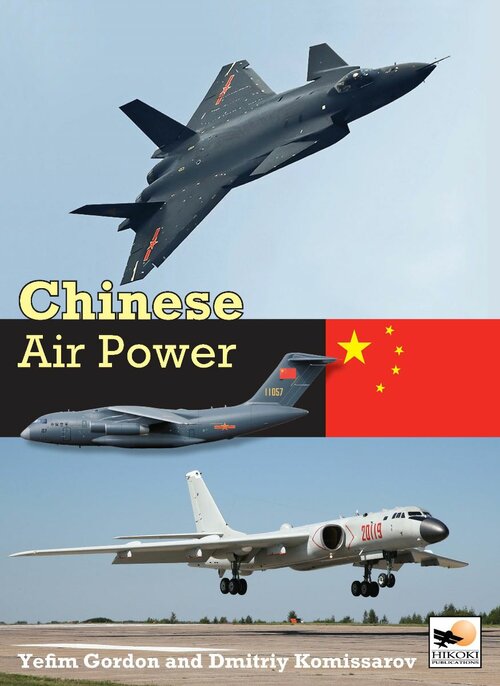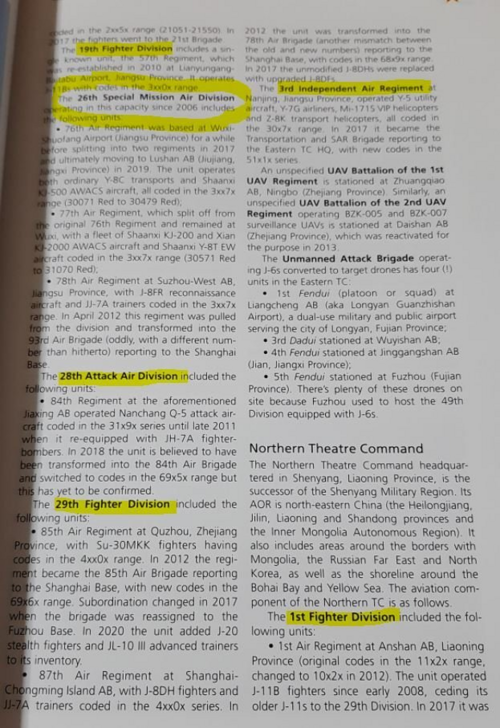Hi guys ... after some very intensive reading during the weekend (and some troubles with my wife) here’s my review to follow for those, who are interested. Honestly for now it won’t be as comprehensive as for Yefim Gordon’s other book on the “Chinese Aviation Industry”, … just some brief first impressions of the first chapters and everything else I will leave it up to You:
Content:
1. PLAAF Order of Battle
2. PLAAF Aircraft Types
3. The PLAAF in Action
4. Naval Aviation
5. Army Aviation
6. PLAAF Training Establishments and Test Centres
7. Police Wings
8. Prospects
Overall an impressive content to cover all “Chinese Air Forces”, their aircraft, Orbat and so on, but let’s start chapter-wise... :
Introduction
Introduction: A quite interesting historical overview of the Air Forces, their foundation, political background and equipment / doctrine developments.
1. PLAAF Order of Battle
Also begins (beside an old CG of the J-10 made by “Songbird” as the chapter-page picture) with the introduction of the command organisation, the force structure, serial system and the description of the military regions ... BUT WHY NOT with a chart, tables and esp. a MAP ??
IMO the biggest disappointment then is the listing of “only” first-line units and their bases. Right with the current situation in mind that several bases are under modernisation, that many units are under relocation, reassignment or merging it’s sometimes difficult to say, where which unit is currently based and equipped with what type. So at least a mentioning of second-line bases and their possible assignment would be fine.
And this is IMO the biggest weakness of this chapter: What follows is a simple list of bases by base only by mentioning their location (Province and coordinated) + a short description of where the flight line is located, the dispersal areas, the apron and the tower. ... I doubt if anyone can image how that base looks like only by such a description – maybe a picture from GE would be fine !! – and then a list is missing, what unit is assigned to that base.
For Example:
Anshan AB is located in Liaoning Province; the coordinated are 41° 06’ 00’’ N, 122° 51’ 36’’ E. The base has one concrete runway oriented in a north-east/south-west direction. A parallel taxiway runs on the east side with a flight line in the middle and angled QRA hardstands at both ends. Two more flight lines are located in the second row further east parallel to the runway, with a control tower in between; the south-east flight line features 24 anti-satellite sheds.
A simple picture and a map would have said more ...
The units and their equipment then follows in a table MR by MR ... but again only the first-line units and some of them are wrong (for example the 7. Fighter Division does not uses J-10 ... that was only mentioned briefly and erroneously by Scramble but then changed a few days later.
This chapter end with a brief description of the PLAAF-leadership ... but sadly again without an organigram / diagram of the structure ...
2. PLAAF Aircraft Types
This is again a mixed chapter ... On the PLUS side it begins with a short but complete review of each mayor combat type, most of them shown in several colour profiles – even if most are known from Y.G.’s other book - ... but then IMO the biggest MINUS, why not a list of what unit currently flies or even ever flew what type ? What follows is in some cases pages of lists of all so far spotted individual aircraft. This might be a useful feature, to identify a unit, which is flying that type but to put all numbers (tactical codes) in one list neglects the fact of reassignments, relocations, renumbering and so on, if one individual aircraft leaves one unit to another one, if one unit changed its rank within a division. IMO it says nothing but ... we’ve seen that number once !
Also ... some of the captions below the pictures are wrong and with a little more care, these mistakes could have been omitted.
...
4. Naval Aviation
Similar to the PLAAF-chapter ... but the PLA-NAF doesn’t fly the J-10 ! This info is still based on the CG made by Songbird showing the no. 81247 !
...
8. Prospects
For all interested in Projects and esp. the latest development in Chinese military aviation, this is maybe the most exciting chapter ... but again it falls short of the expectations, since better research could have prevented some mistakes. It begins with the Chengdu J-10B but proceeds then with types like a Shenyang J-12, a Chengdu J-13, Shenyang J-14 and J-15 ... nearly each type once mentioned in any Chinese forum is described as a real type. To mention them is surely useful, but IMO more care would be better.
Similar to Robin (with his review on the latest Secret Projects book I will start with ...
Okay, conclusion time. In the my opinion (and I admit maybe I’m too critical) this book falls short. As an overview of the subject I think this book (together with the other one on the Chinese Aviation Industry) will surely be – as anticipated – the standard book on the PLAAF and Chinese aviation for years … esp. since no-one else will try such a complete one within the next years. BUT I think of several “things” that could have done (much) better with deeper research, cross-checking of different sources and esp. the decision to include maps or tables.
The bottom line or conclusion ? Again here I need to quote Robin:
I think of this book as being the equivalent of a Wikipedia page. A good first reference, which seves as a jumping-off point for further information, to be found elsewhere.
As such it gives an overview over that topic for all, who are not “online” everyday in several Chinese-military forums, Scramble.nl, Chat rooms or blogs ... but I still miss the "Chinese Military Aviation Review" !
6 out of 10.
Cheers,
Deino.



